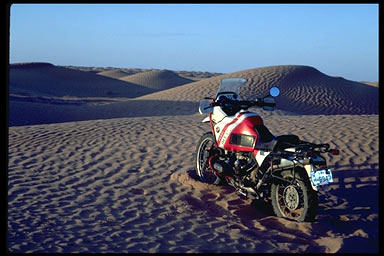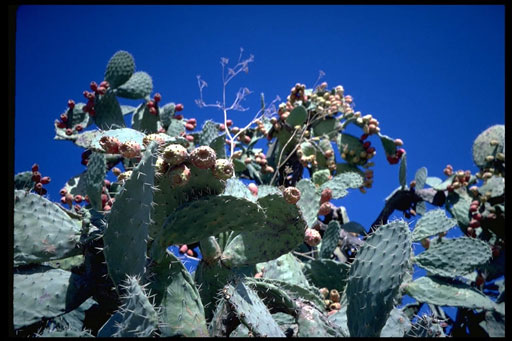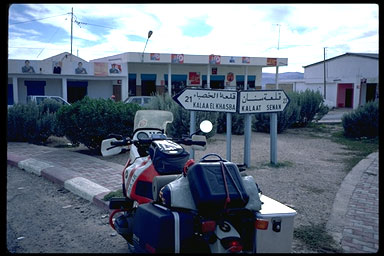| > | > | my moto trip page 1 | . |

|

|
TunisiaTunisie |
Site Map What's New |
Moto Trip 1999 |
Travelogues: Colin in Morocco Me in Tunisia BMW maintenance site: www.oilhead.com |
 sometimes when you stop, you don't even need your kickstand |
|
|
|
|
|
In October 1999 I quit my job in southern Italy, and took a couple of weeks to ride Tunisia. I wanted it to be a really adventuresome trip. I spoke with anyone that I could find that had ever been there. I purchased maps, including Soviet military topographic maps of the southern part of the country from Daerr's in Munich.
On the ride down, I was shocked to see how close Sicily is to mainland Italy. I think that I could have swum across at the closest point without much difficulty. I rode along the northern coast of the island and passed through a little town just filled with beautiful ceramic tile shops. On the outskirts of Palermo, I found myself behind an Italian couple on a BMW sports-tourer in heavy traffic. They were either locals, or a combination of skill and stupidity that match well. Once I decided to not lose them at any cost, I found myself racing through the rush-hour (or is it just always like that?) traffic. I think that the confidence that I felt zipping between crawling cars at a good speed I've only felt a couple of times. I made it from one side of Palermo to the other in what must be record time for a non-Italian, and simultaneously had one of the several perfect moments of this trip.
 The ferry only leaves Trapani on Mondays, so missing the boat is a horrible thought. It also created the interesting fact that my trip could not have been made in any length of time other than increments of seven days. There are also ferries from Genoa, Naples, and Marseillie, although I think that the ferry that I took is the same ferry from Genoa and Naples, I just didn't pick it up there. I bought an apple just before the ferry left that was probably twice as big as the biggest apple that I had seen prior. I even enjoyed eating it, I had been expecting a soft mealy apple.
The ferry only leaves Trapani on Mondays, so missing the boat is a horrible thought. It also created the interesting fact that my trip could not have been made in any length of time other than increments of seven days. There are also ferries from Genoa, Naples, and Marseillie, although I think that the ferry that I took is the same ferry from Genoa and Naples, I just didn't pick it up there. I bought an apple just before the ferry left that was probably twice as big as the biggest apple that I had seen prior. I even enjoyed eating it, I had been expecting a soft mealy apple.
By the time that the ship arrived, I had cleared my passport, and was on my way over the road that crosses the lake between the harbor and the city of Tunis, darkness had begun to fall. I had made no plans for where to stay, so I immediately fell into the Hostel plans of a French couple that I had met on the ferry. They were touring Tunisia for several weeks on bicycles with their young (maybe four?) daughter in tow in a covered trailer. I ran into them on the other side of the bridge and I followed them the rest of the way. I would have never found the Hostel in the confusing and convoluted medina, had it not been for my French-speaking guides. I followed them through all of the dark (quite dark by now) and narrow streets of the medina. Because of some renovation work and the resulting street closures, coupled with the darkness, it took us over a half an hour to find the Hostel. The hostel in Tunis is a beautiful old palace in the heart of the Medina (old-town). They even allow you to bring bicycles and (sometimes) motorcycles inside. I met several interesting tourists there, including the Algerian track team in Tunis for a marathon. Everyone was super friendly and the Algerians even showed me around town a little.
The hostel in Tunis is a beautiful old palace in the heart of the Medina (old-town). They even allow you to bring bicycles and (sometimes) motorcycles inside. I met several interesting tourists there, including the Algerian track team in Tunis for a marathon. Everyone was super friendly and the Algerians even showed me around town a little.
I left Tunis the next day and headed north towards Bizerte. I wanted to see some of the northern coast as well as two big cargo ships, wrecked right on the shore, as well as try out some off-piste riding and get my first taste of sand on my big cow of a bike. Although my BMW R100GS is a really heavy machine, the new R1100GS, R1150GS are even bigger pigs, geared higher, and with street sized wheels, yet morons still head into sand with them. I'd like to say that you'd never catch me being that stupid, but my bike was inopportune enough that I'm not really justified in taking any high ground. The bottom line is that if you do the tour self-supported, you'll have some trouble in the soft stuff. If you want to have a lot of fun off-road, get in on a group with a hired truck and have tons of fun on a light-weight, unencombered bike. Check www.overcross.de for truck-supported German trips to Tunisia, I'm sure that they could accomodate an English speaker.

Slightly east of Bizerte is a park filled with pine trees and the occasional dune making its way through the park. My guidebook mentioned some offroad routes through the park to get to Bizerte. I misunderstood the directions, and turned off the road much earlier than I had expected. I found myself heading towards the beach on some fun sandy dirt roads. I think that I was already aware that I wasn't on the trails that the guidebook was directing me to, but the trails were so much fun, and the view of the ocean so beautiful, that I decided to just go to the beach and follow it to Bizerte if the trail didn't continue. That way I would also be guaranteed of seeing the big wrecks that I could alreay see on the distant coast, right below the looming city of Bizerte. The guide book that I used, and the only that I have seen that cover small roads and off-road to any degree was a German guide from "Reise Know-How". I highly recommend them, there is nothing that comes close to the quality, and nothing available at all in English for a traveller with their own vehicle. If you don't speak German though, there's not much that you can do.

The sand at this point was standard big grain beach sand, just like any beach that I've seen anywhere. I continued along the beach, long after any trace of a trail had ended. The going got tougher and tougher for me, until I finally got stuck in sand so deeply, that I realized I couldn't just paddle and power my way out of this one. I was too afraid to blast over the sand at 20+ mph, so I often found myself paddling with both feet, as I gassed it in first gear. With no sand experience, my situation only worsened. The more I dug around the back wheel, the more the whole rear-end sank in. Eventually, the front wheel was in the air and the license plate was buried! I lost several hours here, but learned some lessons I would need later. One of the many lessons learned includes taking the time to remove luggage and gear from the left side (my pushing side) right away, instead of thinking that I'll save time by not unpacking. I learned that digging below the wheels made things worse. I tried the lay-it-down-and-then-pick-it-back-up-again method but it didn't work for me very well for some reason. I've seen others use it successfully.
After several hours of digging, pushing, thinking, and sweating, I finally got it out. It's amazing how fear of getting stuck again overcomes the fear of going too fast in the sand. Once I was out, I flew through the sand to the next patch of rock. I was excited as I approached the ever growing ships, but at around a quarter-mile away, I had to stop at cliff that dropped off about 15 feet in front of me. It went all the way to the ocean, and, believe it or not, there was a military shooting range on the other side of the dune parralleling the water. There was no place to go but back. The return trip saw no bog-downs and the little experience that I had gained brought me back to the trail's end in a fraction of the time. The encroaching darkness made it difficult to see the trail while riding, so I set up camp right on the trail. I've already said it, but what I learned this day, in the large grain beach sand, before I hit the hot desert, made later parts of the trip possible.
I spent the next morning in Bizerte, looking around the old fort and taking in a cafe or two. I yearned for the adventure awaiting me down south, so I didn't stay long. After a half-day in Bizerte, I rode south for a while, then went up onto the Jebel Goraa mountain and camped there. There is a big communications station up there, and I passed some semi-nomads in their Berber tents up on the plateu. They had som horses and other animals, but there were tiered planting areas, although they looked like they hadn't been used in a while, maybe years. There was a rocky outcropping at the top, and from there I could see the whole valley before me and had a wonderful sunset.

I rolled into Dougga shortly after it opened. That's the way to do it. It's not as hot early in the morning, and, at certain times in the year, the place is overrun with German senior citizens and other tourists. When I showed up, there was only one car in the parking lot, a couple of hours later, the staff had found me wandering around the old structures and asked me to move my bike, because all of the RV's (Caravans for you Brits) were having a hard time parking. The picture to the right is a detail from Roman ruin at Dougga. The site was very open and in good condition. There was plenty of evidence of restoration and recording efforts, so it should be around for a long time to come.

Dougga is an old Roman city site, built upon an old Phonecian site, and still has a tower, that, if I remember correctly, is one of the only examples of Phonecian architecture left. Dougga wasn't as wealthy as some of the larger cities up north, but you can still see signs of opulence. The highlight for me was a beautiful theatre with the engraved writing still very clearly visible in the stone. Get a guidebook to better understand what everything is, and how the city worked. The Lonely Planed guide to Tunisia has a map and lots of details about the city and it's ruins.
The city itself was never occupied after the Romans, I believe, but there are still some people living above the city in little shacks. I bought some cactus fruit and an old Roman coin for what I thought was cheap, but was probably way too expensive for the local economy. The cactus grows everywhere, but I wasn't about to figure out on my own how to get all of the needles off the outside of the fruit. Once you learn to not chew too hard and get the seeds stuck all in your teeth, these cactus fruits become addictively tasty.

I left Dougga in the afternoon and made my way down to Ghafsa. I had read that you can stay in youth centers, similar to hostels. I guess that most of them are just schools when not in the school year. Once I found the place, it was pretty obvious that not many foreigners had stayed there. It was a big dormitory, and appeared to be used mostly by athletes and sports teams travelling within Tunisia for games and meets. I had missed the dinner that they cooked, and with a little bit of sign language and their limited knowledge of English, I got one of the students to show me to a place where I could still get something to eat that late. He took me to a little corner market, and the guy made me a sort of a veggie sub sandwich (maybe it had some fish in it, I can't remember), the highlights being the fresh bread, the olives and the hot sauce. I ate it in my room, since there was no place to sit there, and it was already after dark.
When I awoke in Ghafsa, I noticed that I was already in a different land. The trees and vegetation were gone, as was most of the topography. It was flat in all directions and the clouds were sparse. I made my way south towards the real desert. I had decide to hit two spots near the Algerian border, an oasis and a small village abandoned in the late sixties. As the turn approached in the distance, I could see about a dozen really bright glinting objects on the road beyond the turn, but couldn't really tell what they were.
|
|
|
|
|